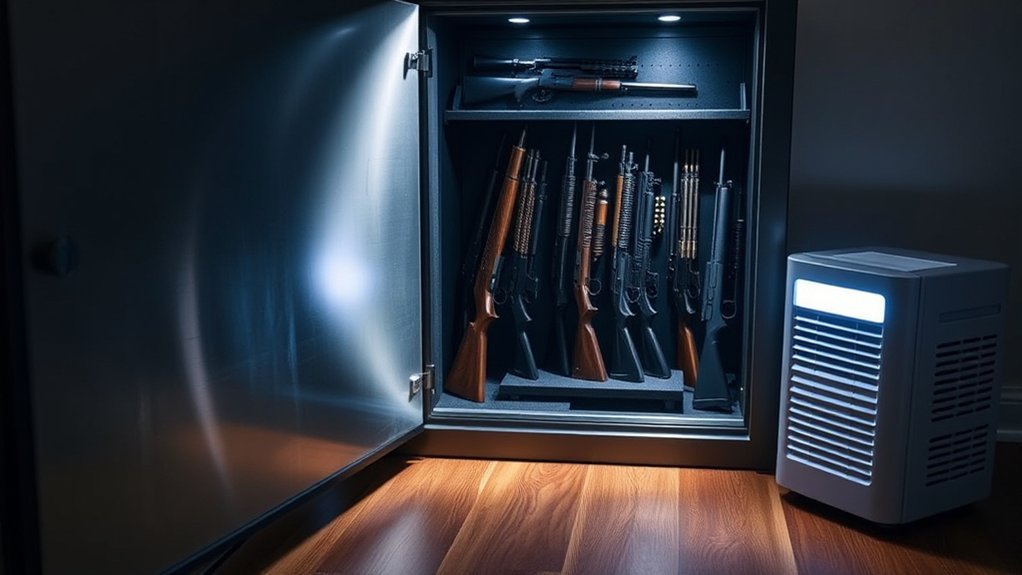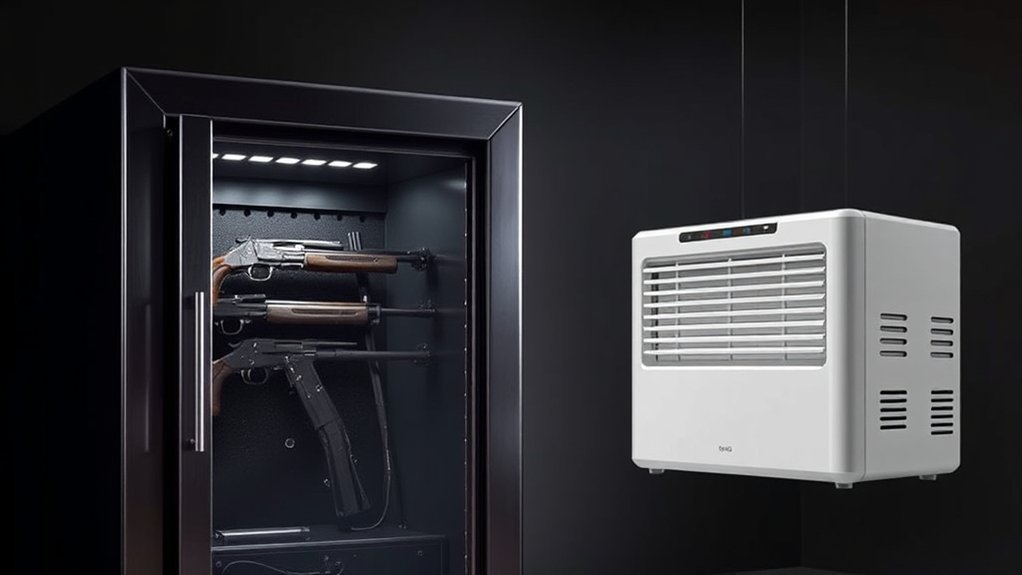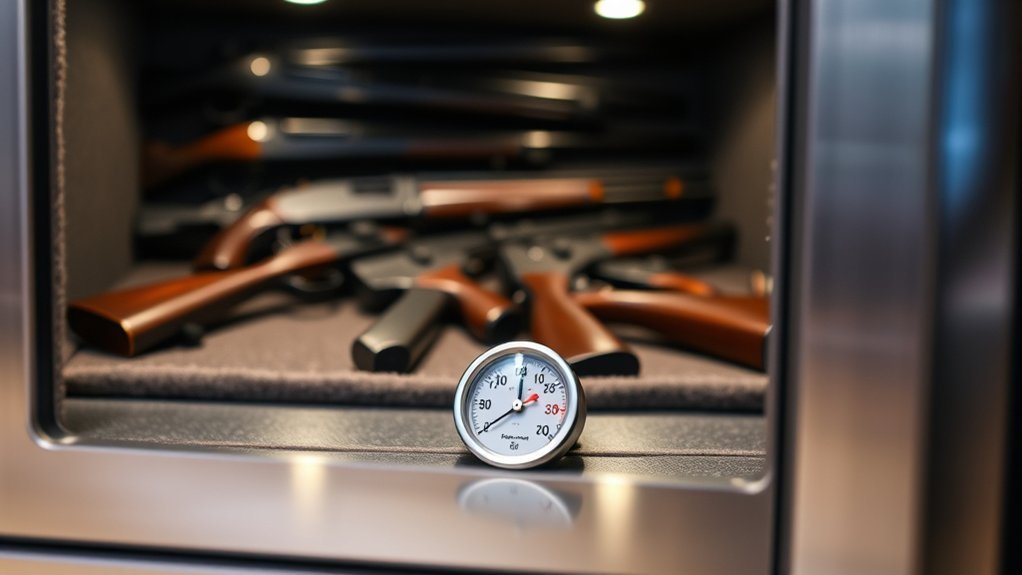Your gun safe could be a breeding ground for corrosion if humidity isn’t controlled. Maintaining the right humidity levels is essential for protecting your firearms and valuables from damage. Understanding what causes moisture and the methods available to combat it can make a significant difference. From electric dehumidifiers to practical DIY solutions, you’ll find various options to guarantee your safe remains a secure environment for your prized possessions.
Recognize Acceptable Humidity Levels for Gun Safes
When storing firearms, it is vital to recognize acceptable humidity levels to prevent damage and guarantee longevity. The NRA recommends maintaining humidity levels between 30% and 50% in gun safes to protect against corrosion and mold growth. If humidity levels exceed 70%, metal components can start to corrode within just four days, making it important to control the humidity. To achieve this, consider using a dehumidifier, especially in areas with higher moisture. Regularly checking with a hygrometer confirms that you maintain ideal conditions. Keeping humidity at or below 50% not only extends the lifespan of your guns but also safeguards wooden stocks and guarantees ammunition reliability. Monitoring humidity is a significant step in preserving your valuable firearms.
What Causes Moisture in a Safe?

Moisture in your gun safe often stems from humid air infiltrating the space, especially if the safe isn’t properly sealed. Temperature fluctuations can also contribute, as they may cause condensation to form inside when colder items are stored without warming. Additionally, if you place damp firearms in the safe, they can release moisture, further elevating humidity levels.
Humid Air Infiltration
Humidity often sneaks into gun safes through various means, especially if they aren’t adequately sealed. This infiltrating humid air can lead to several issues if not managed. Here are the primary causes of moisture accumulation:
- Poor Sealing: Most safes aren’t airtight, allowing humid air from your home to enter.
- Indoor Climate Control: Swamp coolers and air conditioning can increase humidity levels, impacting air circulation inside the safe.
- Proximity to Water Bodies: Living near lakes or rivers can elevate humidity levels in the air, affecting the safe’s internal environment.
- Dew on Firearms: Moisture from dew-covered guns can saturate the safe’s interior, increasing condensation and disrupting proper humidity management.
Addressing these factors is essential for preventing moisture issues.
Temperature Fluctuations
Temperature fluctuations can greatly impact the interior conditions of your gun safe, leading to increased moisture levels. When cold firearms are moved indoors, condensation forms, raising humidity levels. This moisture can cause serious issues, including corrosion and mold growth on your firearms.
| Causes of Temperature Fluctuations | Effects on Humidity Levels |
|---|---|
| Moving cold items indoors | Increased condensation |
| Proximity to water bodies | Higher humidity levels |
| Use of swamp coolers | Rapid temperature changes |
To maintain humidity control and keep your safe dry, aim for consistent temperatures. Remember, humidity levels above 70% can accelerate corrosion within just a week, making it vital to monitor your safe’s environment regularly.
Cold Firearm Condensation
How can you prevent the condensation that forms on cold firearms when they’re brought indoors? Cold firearm condensation can lead to moisture buildup and excessive moisture within your gun safe. To safeguard your firearms, consider these steps:
- Allow firearms to warm up gradually to room temperature before placing them in the safe.
- Wipe off any condensation that forms on the firearm’s surface.
- Confirm your safe is well-sealed to minimize outside air infiltration.
- Use a dehumidifier to maintain ideal humidity levels within the safe.
Experts recommend these practices to prevent moisture accumulation, which can lead to corrosion and damage. Proper safe storage is critical in maintaining the integrity of your firearms and preventing issues related to humidity.
Gun Safe Dehumidifiers

When it comes to gun safe dehumidifiers, you’ll find several options to effectively manage humidity levels. Plug-in models, like the Dry Rod, and rechargeable silica gel packs each offer unique benefits for moisture control, helping to prevent corrosion and mold. By understanding the different types available, you can choose the best solution for your specific environment and needs.
Types of Dehumidifiers
To effectively control humidity in your gun safe, understanding the various types of dehumidifiers available is essential. Each type serves a unique purpose in maintaining ideal humidity levels to protect your firearms. Here are four options to take into account:
- Electric dehumidifier: Plug-in rods generate heat to evaporate moisture, ideal for high-humidity areas.
- Rechargeable dehumidifier: Silica gel options absorb moisture and can be easily recharged, great for smaller safes.
- Non-electric moisture absorbers: Silica gel packs and calcium chloride crystals are cost-effective but need regular replacement.
- Combination systems: Pairing electric models with gun socks enhances moisture protection and cleanliness in your gun safes.
Choosing the right type can greatly impact the longevity and condition of your firearms.
Benefits of Dehumidifiers
Investing in dehumidifiers for your gun safe brings significant advantages, particularly in preserving the condition of your firearms. Safe dehumidifiers help maintain humidity levels between 30% and 50%, essential for preventing rust and corrosion. By actively removing moisture, these devices can extend the lifespan of your guns by decades and reduce mold growth risks. Electric options, like the Dry Rod, continuously operate to eliminate moisture, making them ideal for humid environments, while rechargeable silica gel dehumidifiers, which include desiccant packs, absorb moisture and indicate saturation. The National Rifle Association (NRA) recommends combining electric and non-electric dehumidifiers for thorough humidity control, ensuring your firearms remain in peak condition and wooden stocks avoid warping.
Practical Methods to Minimizing Moisture in a Gun Safe
Maintaining ideal humidity levels in your gun safe is essential for preserving your firearms and preventing rust and corrosion. To effectively minimize moisture, consider these practical methods:
- Install a hygrometer: Regularly monitor humidity levels, ensuring they stay between the recommended 30% to 50% for best protection.
- Use dehumidifiers: Electric options like the Dry Rod circulate air and evaporate moisture, especially in high humidity environments.
- Incorporate silica gel packs: These rechargeable moisture absorbers can soak up to 40% of their weight in water, helping maintain a dry environment.
- Air out the safe: Open it every two weeks to prevent condensation and allow trapped moisture to escape, as the NRA recommends.
Regular maintenance of these methods is vital for effective humidity control.
Explore Electric and Non-Electric Dehumidifiers
While humidity control is essential for protecting your firearms, choosing the right dehumidifier can greatly impact your gun safe’s environment. Electric dehumidifiers, like the Golden Rod, generate heat to evaporate moisture, offering continuous protection against humidity issues. Non-electric options, such as silica gel packets, absorb moisture effectively but need regular replacement or recharging when saturated.
Here’s a comparison of both types:
| Type | Advantages | Disadvantages |
|---|---|---|
| Electric Dehumidifiers | Continuous humidity control | Requires power |
| Non-Electric Dehumidifiers | Cost-effective, maintenance-free | Requires regular replacement |
| Golden Rod | Easy installation, effective | Limited by space and heat output |
| Silica Gel Packets | Compact, rechargeable | Needs monitoring for saturation |
Using a mix of both can enhance humidity control in your gun safe.
Importance of Humidity Control for Firearms and Valuables
Humidity control is essential for preserving the integrity of your firearms and other valuables stored in gun safes. Maintaining proper humidity levels helps prevent damage and guarantees longevity. Here are four key points to reflect on:
- NRA recommends keeping humidity levels between 30% and 50% to minimize the risk of corrosion and rust on your firearms.
- Excess moisture levels can lead to mold growth, affecting both firearms and documents stored nearby.
- Guns can corrode within a week if humidity levels exceed 70%, highlighting the need for consistent monitoring.
- Invest in a quality dehumidifier and regularly check humidity levels with a hygrometer to prevent damage to firearms and secure ideal storage conditions.
Taking these steps will protect your valuables effectively.
Conclusion
Maintaining proper humidity levels in your gun safe isn’t just a nice-to-have; it’s essential for preserving your firearms and valuables. By using effective dehumidifiers and implementing practical moisture-reducing methods, you can greatly reduce the risk of corrosion and mold. So, why risk losing your valuable investments to dampness? Regular monitoring and maintenance will not only enhance the longevity of your items but also provide peace of mind knowing they’re well-protected.

